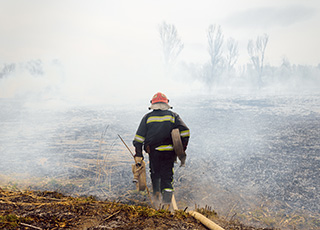NIH Program on Health and Extreme Weather

Building Preparedness for Vector-Borne Diseases
Researchers in New York revealed crucial insight to enhance malaria prevention preparedness in response to changing temperatures and improve risk models that assess the impact of vector-borne diseases on public health in the U.S. They identified the optimal, minimum, and maximum temperatures at which malaria-carrying mosquitoes are most effective as vectors for transmission. (Villena et al., 2022)
Understanding Long-Term Health Impacts of Wildfires
NIH-funded researchers are examining the long-term health impacts of wildfires on Maui residents in Hawaii. They are also deploying a data-driven toolkit to support recovery efforts, guide decision-making, and enhance disaster preparedness. (R61MD019793)
Strategies for Improving Asthma After Hurricanes
Health care providers should facilitate proactive hurricane plans for children with asthma, according to an NIH-funded study in North Carolina. Scientists revealed how hurricane damage, flooding, mold, mildew, and disrupted access to care worsened quality of life for children with the disease. (Davis et al., 2023)
Opportunities to Decrease Dementia Associated With Wildfires
Researchers found increased risk of dementia diagnosis among older Southern California residents exposed to wildfire particulate matter in air, pointing to opportunities for air pollution interventions to protect neurological health. (Elser et al., 2025)
Common Medications Make Older Adults More Sensitive to Heat
Scientists in North Carolina revealed that common medications used to treat chronic conditions, particularly in older adults, make patients more sensitive to heat. This knowledge can help physicians ensure their patients take proper precautions during heat events to protect their health. (Layton et al., 2020)
Children’s Mental Health Affected by Disasters Years Later
NIH-funded scientists revealed lasting effects on children’s mental health after experiencing disasters. Children of mothers in Louisiana who experienced more stressors related to Hurricane Katrina had worse mental health over a decade later. (Zacher et al., 2022)
Improving Community Health Through Tree Planting Initiatives
NIH-funded researchers in Kentucky are exploring how trees and greenery can improve cardiovascular health by reducing air pollution. (Riggs et al., 2021; R01ES029846)
Increased Emergency Admissions During Harmful Algal Blooms
Researchers found a significant increase in gastrointestinal emergency room admissions during a heat-related red tide bloom in Florida. The findings underscore the increased burden on health care resources during red tide blooms and the need for better public health recommendations and health care provider education. (Kirkpatrick et al., 2010)
Heart Health Complicated by Exposures During Drought
Researchers are exploring the cardiometabolic health risks posed by higher arsenic exposures during drought in aging rural Colorado communities. They are also developing predictive models using machine learning to explore how interventions can reduce exposure to arsenic and improve health outcomes. (R01ES032612)
Reducing Flooding Impacts Through Urban Planning
NIH-funded researchers in Texas are using new infrastructure strategies — such as water-absorbing rain gardens — on vacant lands to help cities reduce the severity of flooding and contamination issues after flooding events. (Newman et al., 2020)
Improving Health Outcomes in Breast Cancer Patients Following Severe Storms
Researchers in New Jersey are assessing adverse health outcomes experienced by patients with breast cancer due to treatment disruptions following severe storms to identify targeted interventions to improve breast cancer care post-storm. (K08CA283268)


